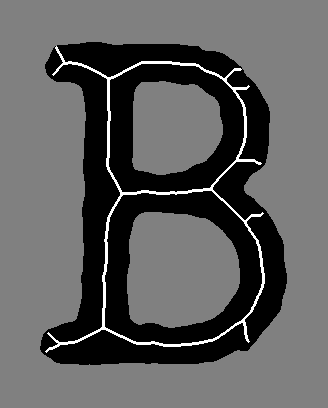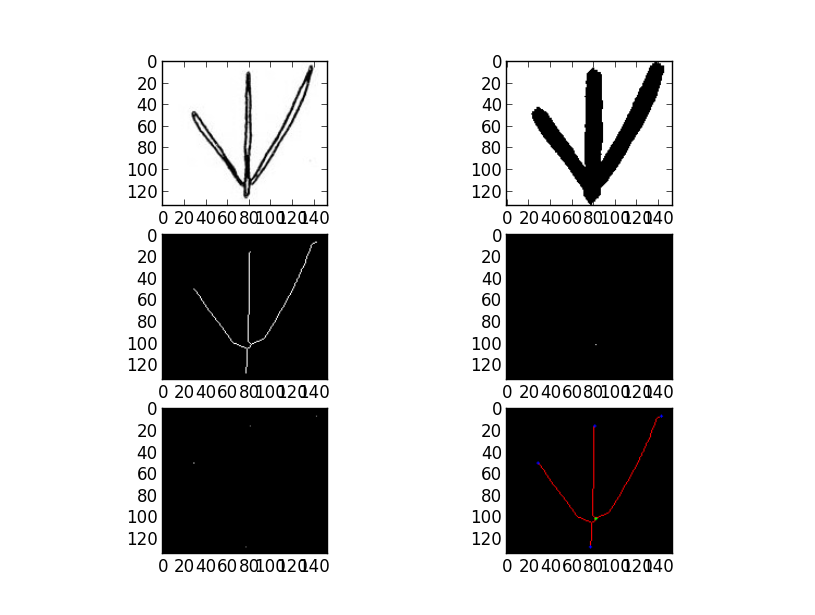|
Morphological Skeleton
In digital image processing, morphological skeleton is a skeleton (or medial axis) representation of a shape or binary image, computed by means of morphological operators. Morphological skeletons are of two kinds: * Those defined by means of morphological openings, from which the original shape can be reconstructed, * Those computed by means of the hit-or-miss transform, which preserve the shape's topology. Skeleton by openings Lantuéjoul's formula Continuous images In ( Lantuéjoul 1977),See also ( Serra's 1982 book) Lantuéjoul derived the following morphological formula for the skeleton of a continuous binary image X\subset \mathbb^2: :S(X)=\bigcup_\bigcap_\left X\ominus \rho B)-(X\ominus \rho B)\circ \mu \overline B\right/math>, where \ominus and \circ are the morphological erosion and opening, respectively, \rho B is an open ball of radius \rho, and \overline B is the closure of B. Discrete images Let \, n=0,1,\ldots, be a family of shapes, where ''B'' is a structuri ... [...More Info...] [...Related Items...] OR: [Wikipedia] [Google] [Baidu] |
Digital Image Processing
Digital image processing is the use of a digital computer to process digital images through an algorithm. As a subcategory or field of digital signal processing, digital image processing has many advantages over analog image processing. It allows a much wider range of algorithms to be applied to the input data and can avoid problems such as the build-up of noise and distortion during processing. Since images are defined over two dimensions (perhaps more) digital image processing may be modeled in the form of multidimensional systems. The generation and development of digital image processing are mainly affected by three factors: first, the development of computers; second, the development of mathematics (especially the creation and improvement of discrete mathematics theory); third, the demand for a wide range of applications in environment, agriculture, military, industry and medical science has increased. History Many of the techniques of digital image processing, or digita ... [...More Info...] [...Related Items...] OR: [Wikipedia] [Google] [Baidu] |
Set Union
In set theory, the union (denoted by ∪) of a collection of sets is the set of all elements in the collection. It is one of the fundamental operations through which sets can be combined and related to each other. A refers to a union of zero (0) sets and it is by definition equal to the empty set. For explanation of the symbols used in this article, refer to the table of mathematical symbols. Union of two sets The union of two sets ''A'' and ''B'' is the set of elements which are in ''A'', in ''B'', or in both ''A'' and ''B''. In set-builder notation, :A \cup B = \. For example, if ''A'' = and ''B'' = then ''A'' ∪ ''B'' = . A more elaborate example (involving two infinite sets) is: : ''A'' = : ''B'' = : A \cup B = \ As another example, the number 9 is ''not'' contained in the union of the set of prime numbers and the set of even numbers , because 9 is neither prime nor even. Sets cannot have duplicate elements, so the union of the sets and is . Multip ... [...More Info...] [...Related Items...] OR: [Wikipedia] [Google] [Baidu] |
Structuring Element
In mathematical morphology, a structuring element is a shape, used to probe or interact with a given image, with the purpose of drawing conclusions on how this shape fits or misses the shapes in the image. It is typically used in morphological operations, such as dilation, erosion, opening, and closing, as well as the hit-or-miss transform. According to Georges Matheron, knowledge about an object (e.g., an image) depends on the manner in which we probe (observe) it.See ( Dougherty 1992), chapter 1, page 1. In particular, the choice of a certain structuring element for a particular morphological operation influences the information one can obtain. There are two main characteristics that are directly related to structuring elements: * Shape. For example, the structuring element can be a "ball" or a line; convex or a ring, etc. By choosing a particular structuring element, one sets a way of differentiating some objects (or parts of objects) from others, according to their shape or ... [...More Info...] [...Related Items...] OR: [Wikipedia] [Google] [Baidu] |
Radius
In classical geometry, a radius ( : radii) of a circle or sphere is any of the line segments from its center to its perimeter, and in more modern usage, it is also their length. The name comes from the latin ''radius'', meaning ray but also the spoke of a chariot wheel. as a function of axial position ../nowiki>" Spherical coordinates In a spherical coordinate system, the radius describes the distance of a point from a fixed origin. Its position if further defined by the polar angle measured between the radial direction and a fixed zenith direction, and the azimuth angle, the angle between the orthogonal projection of the radial direction on a reference plane that passes through the origin and is orthogonal to the zenith, and a fixed reference direction in that plane. See also *Bend radius *Filling radius in Riemannian geometry *Radius of convergence *Radius of convexity * Radius of curvature *Radius of gyration ''Radius of gyration'' or gyradius of a body about the axis of ro ... [...More Info...] [...Related Items...] OR: [Wikipedia] [Google] [Baidu] |
Open Ball
In mathematics, a ball is the solid figure bounded by a ''sphere''; it is also called a solid sphere. It may be a closed ball (including the boundary points that constitute the sphere) or an open ball (excluding them). These concepts are defined not only in three-dimensional Euclidean space but also for lower and higher dimensions, and for metric spaces in general. A ''ball'' in dimensions is called a hyperball or -ball and is bounded by a ''hypersphere'' or ()-sphere. Thus, for example, a ball in the Euclidean plane is the same thing as a disk, the area bounded by a circle. In Euclidean 3-space, a ball is taken to be the volume bounded by a 2-dimensional sphere. In a one-dimensional space, a ball is a line segment. In other contexts, such as in Euclidean geometry and informal use, ''sphere'' is sometimes used to mean ''ball''. In the field of topology the closed n-dimensional ball is often denoted as B^n or D^n while the open n-dimensional ball is \operatorname B^n or \o ... [...More Info...] [...Related Items...] OR: [Wikipedia] [Google] [Baidu] |
Erosion (morphology)
Erosion (usually represented by ⊖) is one of two fundamental operations (the other being dilation) in morphological image processing from which all other morphological operations are based. It was originally defined for binary images, later being extended to grayscale images, and subsequently to complete lattices. The erosion operation usually uses a structuring element for probing and reducing the shapes contained in the input image. Binary erosion In binary morphology, an image is viewed as a subset of a Euclidean space \mathbb^d or the integer grid \mathbb^d, for some dimension ''d''. The basic idea in binary morphology is to probe an image with a simple, pre-defined shape, drawing conclusions on how this shape fits or misses the shapes in the image. This simple "probe" is called structuring element, and is itself a binary image (i.e., a subset of the space or grid). Let ''E'' be a Euclidean space or an integer grid, and ''A'' a binary image in ''E''. The erosion of the ... [...More Info...] [...Related Items...] OR: [Wikipedia] [Google] [Baidu] |
Topology
In mathematics, topology (from the Greek words , and ) is concerned with the properties of a geometric object that are preserved under continuous deformations, such as stretching, twisting, crumpling, and bending; that is, without closing holes, opening holes, tearing, gluing, or passing through itself. A topological space is a set endowed with a structure, called a '' topology'', which allows defining continuous deformation of subspaces, and, more generally, all kinds of continuity. Euclidean spaces, and, more generally, metric spaces are examples of a topological space, as any distance or metric defines a topology. The deformations that are considered in topology are homeomorphisms and homotopies. A property that is invariant under such deformations is a topological property. Basic examples of topological properties are: the dimension, which allows distinguishing between a line and a surface; compactness, which allows distinguishing between a line and a circle; co ... [...More Info...] [...Related Items...] OR: [Wikipedia] [Google] [Baidu] |
Topological Skeleton
In shape analysis, skeleton (or topological skeleton) of a shape is a thin version of that shape that is equidistant to its boundaries. The skeleton usually emphasizes geometrical and topological properties of the shape, such as its connectivity, topology, length, direction, and width. Together with the distance of its points to the shape boundary, the skeleton can also serve as a representation of the shape (they contain all the information necessary to reconstruct the shape). Skeletons have several different mathematical definitions in the technical literature, and there are many different algorithms for computing them. Various different variants of skeleton can also be found, including straight skeletons, morphological skeletons, etc. In the technical literature, the concepts of skeleton and medial axis are used interchangeably by some authors,, Section 11.1.5, p. 650 while some other authors, Section 9.9, p. 382., Section 17.5.2, p. 234. regard them as rel ... [...More Info...] [...Related Items...] OR: [Wikipedia] [Google] [Baidu] |
Hit-or-miss Transform
In mathematical morphology, hit-or-miss transform is an operation that detects a given configuration (or pattern) in a binary image, using the morphological erosion operator and a pair of disjoint structuring elements. The result of the hit-or-miss transform is the set of positions where the first structuring element fits in the foreground of the input image, and the second structuring element misses it completely. Mathematical definition In binary morphology, an image is viewed as a subset of a Euclidean space \mathbb^d or the integer grid \mathbb^d, for some dimension ''d''. Let us denote this space or grid by ''E''. A structuring element is a simple, pre-defined shape, represented as a binary image, used to probe another binary image, in morphological operations such as erosion, dilation, opening, and closing. Let C and D be two structuring elements satisfying C\cap D=\emptyset. The pair (''C'',''D'') is sometimes called a ''composite structuring element''. The hit-or ... [...More Info...] [...Related Items...] OR: [Wikipedia] [Google] [Baidu] |





